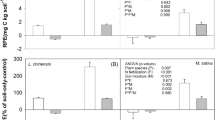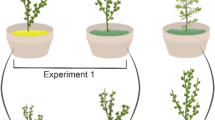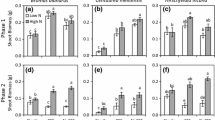Abstract
Background and aims
There is evidence that the invasive grass Bromus tectorum can affect soil nitrogen (N) cycling, possibly leading to a positive plant-soil feedback. Rhizosphere priming of N mineralization could provide a mechanistic explanation for such a feedback.
Methods
We conducted a greenhouse study to isolate rhizosphere effects on N cycling by the invasive annual grass, Bromus tectorum L., and the native perennial grass, Elymus elymoides (Raf.) Swezey, in invaded and uninvaded soils. We compared the rhizosphere priming effect (RPE) on N mineralization by species and the distribution of N in various pools by planting treatment and soil type.
Results
B. tectorum had a negative RPE (−23 and −22 % in invaded and uninvaded soils, respectively), while E. elymoides had no significant RPE. B. tectorum was more competitive over E. elymoides in invaded compared to uninvaded soil.
Conclusions
B. tectorum had a negative effect on soil N availability via root-mediated processes, even though its growth and competitiveness increased in invaded soils. Positive plant-soil feedback effects of B. tectorum may be mediated by aboveground inputs rather than belowground and/or depend on site-specific conditions.

Similar content being viewed by others
Abbreviations
- N:
-
Nitrogen
- RPE:
-
Rhizosphere priming effect
References
Arrendondo JT, Jones TA, Johnson DA (1998) Seedling growth of Intermountain perennial and weedy annual grasses. J Range Manage 51:584–589
Belnap J, Phillips SL (2001) Soil biota in an ungrazed grassland- Response to annual grass (Bromus tectorum) invasion. Ecol Appl 11(5):1261–1275
Belnap J, Phillips SL, Moldenke AR, Sherrod SK (2005) Soil biota can change after exotic plant invasion- does this affect ecosystem processes? Ecology 86(11):3007–3017
Bird JA, Herman DJ, Firestone MK (2011) Rhizosphere priming of soil organic matter by bacterial groups in a grassland soil. Soil Biol Biochem 43:718–725
Blank RR, Morgan TA (2013) Soil engineering facilitates downy brome (Bromus tectorum) growth- a case study. Inv Plant Sci Manage 6:391–400
Blank RR, Young JA (2004) Influence of three weed species on soil nutrient availability. Soil Sci 169(5):385–397
Bolton H, Smith JL, Wildung RE (1990) Nitrogen mineralization potential of shrub-steppe soils with different disturbance histories. Soil Sci Soc Am J 54:887–891
Bolton H, Smith JL, Link SO (1993) Soil microbial biomass and activity of a disturbed and undisturbed shrub-steppe ecosystem. Soil Biol Biochem 25(5):545–552
Booth MS, Stark JM, Caldwell MM (2003) Inorganic N turnover and availability in annual- and perennial-dominated soils in a northern Utah shrub-steppe ecosystem. Biogeochemistry 66(3):311–330
Brookes PC, Landman A, Pruden G, Jenkinson DS (1985) Chloroform fumigation and the release of soil nitrogen: a rapid direct extraction method to measure microbial biomass nitrogen in soil. Soil Biol Biochem 17(6):837–842
Brooks ML (2003) Effects of increased soil nitrogen on the dominance of alien annual plants in the Mojave Desert. J Appl Ecol 40:344–353
Brooks ML, D’Antonio CM, Richardson DM, Grace JB, Keeley JE, DiTomaso JM, Hobbs RJ, Pellant M, Pyke D (2004) Effects of invasive alien plants on fire regimes. Bioscience 54:677–688
Busby RR (2011) Cheatgrass (Bromus tectorum L) interactions with arbuscular mycorrhizal fungi in the North American steppe: prevalence and diversity of associations, and divergence from native vegetation. Dissertation, Colorado State University
Cabrera MR, Beare MH (1993) Alkaline persulfate oxidation for determining total nitrogen in microbial biomass extracts. Soil Sci Soc Am J 57:1007–1012
Chambers JC, Roundy BA, Blank RR, Meyer SE, Whittaker A (2007) What makes Great Basin sagebrush ecosystems invasible by Bromus tectorum? Ecol Mono 77:117–145
Cheng W (1999) Rhizosphere feedbacks in elevated CO2. Tree Physiol 19:313–320
Cheng W, Johnson DW, Fu S (2003) Rhizosphere effects on decomposition: controls of plant species, phenology, and fertilization. Soil Sci Soc Am J 67:1418–1427
Cheng W, Parton WJ, Gonzalez-Meler MA, Phillips R, Asao S, McNickle GG, Brzostek E, Jastrow JD (2014) Synthesis and modeling perspectives of rhizosphere priming. New Phyt 201:31–44
Concilio A, Loik ME, Belnap J (2013) Global change effects on Bromus tectorum L. (Poaceae) at its high-elevation range margin. Glob Change Biol 19:161–172
Corbin J, D’Antonio CM (2012) Gone but not forgotten? Invasive plants’ legacies on community and ecosystem properties. Inv Plant Sci Manage 5(1):117–124
Dijkstra FA, Bader NE, Johnson DW, Cheng WX (2009) Does accelerated soil organic matter decomposition in the presence of plants increase plant N availability? Soil Biol Biochem 41:1080–1087
Dijkstra FA, Cheng W (2007) Moisture modulates rhizosphere effects on C decomposition in two different soil types. Soil Biol Biochem 39:2264–2274
Ehrenfeld J (2003) Effects of exotic plant invasions on soil nutrient cycling processes. Ecosystems 6:503–523
Ehrenfeld J, Ravit B, Elgersma K (2005) Feedback in the plant-soil system. Ann Rev Environ Resour 30:75–115
Evans RD, Rimer R, Sperry L, Belnap J (2001) Exotic plant invasion alters nitrogen dynamics in an arid grassland. Ecol Appl 11(5):1301–1310
Fontaine S, Barot S (2005) Size and functional diversity of microbe populations control plant persistence and long-term soil carbon accumulation. Ecol Lett 8:1075–1087
Gärdenäs AI, Ågren GI, Bird JA, Clarholm M, Hallin S, Ineson P, Kätterer T, Knicker H, Nilsson SI, Näsholm T, Ogle S, Paustian K, Persson T, Stendahl J (2011) Knowledge gaps in soil carbon and nitrogen interactions- from molecular to global scale. Soil Biol Biochem 43:702–717
Gasch CK, Enloe SF, Stahl PD, Williams SE (2013) An aboveground-belowground assessment of ecosystem properties associated with annual brome invasion. Biol Fertil Soils 49:919–928
Grove S, Haubensak KA, Parker IM (2012) Direct and indirect effects of allelopathy in the soil legacy of an exotic plant invasion. Plant Ecol 213:1869–1882
Guenet B, Leloup J, Raynaud X, Bardoux G, Abbadie L (2010) Negative priming effect on organic matter from a soil free of vegetation for 80 years. Eur J Soil Sci 61:384–391
Grman E, Suding KN (2010) Within-year soil legacies contribute to strong priority effects on native California grassland communities. Restor Ecol 18(5):664–670
Hagen DL, Jose S, Bohn K, Escobedo F (2013) Cogongrass (Imperata cylindrica) invasion and eradication: implications for soil nutrient dynamics in a longleaf pine sandhill ecosystem. Inv Plant Sci Manage 6(3):433–443
Harris GA (1967) Some competitive relationships between Agropyron spicatum and Bromus tectorum. Ecol Mono 37:89–111
Haubensak KA, D’Antonio CM, Alexander J (2004) Effects of nitrogen-fixing shrubs in Washington and coastal California. Weed Technol 18:1475–1479
Huenneke LF, Hamburg SP, Koide R, Mooney HA, Vitousek PM (1990) Effects of soil resources on plant invasion and community structure in California serpentine grassland. Ecology 71:478–491
Humphrey LD, Schupp EW (2004) Competition as a barrier to establishment of a native perennial grass (Elymus elymoides) in alien annual grass (Bromus tectorum) communities. J Arid Env 58(4):405–422
Jones TA, Monaco TA, James JJ (2010) Launching the counterattack: interdisciplinary deployment of native-plant functional traits for repair of rangelands contaminated by invasive annual grasses. Rangelands 32:38–42
Kuske CR, Ticknor LO, Miller ME, Dunbar JM, Davis JA, Barns SM, Belnap J (2002) Comparison of soil bacterial communities in rhizosphere of three plant species and interspaces in an arid grassland. Appl Environ Microbiol 68(4):1854–1863
Lankau RA, Bauer JT, Anderson MR, Anderson RC (2014) Long-term legacies and partial recovery of mycorrhizal communities after invasive plant removal. Biol Invasions 16:1979–1990
Lee MR, Flory SL, Phillips RP (2012) Positive feedbacks to growth of an invasive grass through alteration of nitrogen cycling. Oecologia 170:457–465
Lowe PN, Lauenroth WK, Burke IC (2003) Effects of nitrogen availability on competition between Bromus tectorum and Bouteloua gracilis. Plant Ecol 167:247–254
Mack RN, Simberloff D, Lonsdale WM, Evans H, Clout M, Bazzaz FA (2000) Biotic invasions: causes, epidemiology, global consequences and control. Ecol Appl 10:689–710
MacKown CT, Jones TA, Johnson DA, Monaco TA, Redinbaugh MG (2009) Nitrogen uptake by perennial and invasive annual grass seedlings: nitrogen form effects. Soil Sci Soc Am J 73:1864–1870
Martina JP (2012) Invasive plant species impacts on carbon and nitrogen cycling in inland Michigan wetlands. Dissertation, Michigan State University
Meisner A, de Boer W, Verhoeven KJF, Boschker HTS, van der Putten WH (2011) Comparison of nutrient acquisition in exotic plant species and congeneric natives. J Ecol 99:1308–1315
Monaco TA, Johnson DA, Norton JM, Jones TA, Connors KJ, Norton JB, Redinbaugh MB (2003) Contrasting responses of Intermountain West grasses to soil nitrogen. J Range Manage 56:282–290
Mosley JC, Bunting SC, Manoukian ME (1999) Cheatgrass. In: Biology and Management of noxious rangeland weeds. Sheley, Petroff (Eds). Oregon State University Press. pp.175–188
Norton JB, Monaco TA, Norton JM, Johnson DA, Jones TA (2004) Soil morphology and organic matter dynamics under cheatgrass and sagebrush-steppe plant communities. J Arid Environ 57:445–466
Paschke MW, McLendon T, Redente EF (2000) Nitrogen availability and old-field succession in a shortgrass steppe. Ecosystems 3:144–158
Pausch J, Zhu B, Kuzyakov Y, Cheng WX (2013) Plant inter-species effects on rhizosphere priming of soil organic matter decomposition. Soil Biol Biochem 57:91–99
Perkins LB, Nowak RS (2012) Soil conditioning and plant-soil feedbacks affect competitive relationships between native and invasive grasses. Plant Ecol 213:1337–1344
Perkins LB, Johnson DW, Nowak RS (2011) Plant-induced changes in soil nutrient dynamics by native and invasive grass species. Plant Soil 345:365–374
Rafferty DL, Young JA (2002) Cheatgrass competition and establishment of desert needlegrass seedlings. J Range Manage 55:70–72
Rao LE, Steers RJ, Allen EB (2011) Effects of natural and anthropogenic gradients on native and exotic winter annuals in a southern California Desert. Plant Ecol 212:1079–1089
Rimer RL, Evans RD (2006) Invasion of downy brome (Bromus tectorum L.) causes rapid changes in the nitrogen cycle. Am Mid Nat 156(2):252–258
Saetre P, Stark JM (2005) Microbial dynamics and carbon and nitrogen cycling following rewetting of soils beneath two semi-arid plant species. Oecologia 142:247–260
Schaeffer SM, Ziegler SE, Belnap J, Evans RD (2012) Effects of Bromus tectorum invasion on microbial carbon and nitrogen cycling in two adjacent undisturbed arid grassland communities. Biogeochemistry 111:427–441
Scharfy D, Güsewell S, Gessner MO, Venterink HO (2010) Invasion of Solidago gigantean in contrasting experiment plant communities: effects on soil microbes, nutrients and plant-soil feedbacks. J Ecol 98:1379–1388
Sperry LJ, Belnap J, Evans RD (2006) Bromus tectorum invasion alters nitrogen dynamics in an undisturbed grassland ecosystem. Ecology 87:603–615
Suding KN, Gross KL, Houseman G (2004) Alternative states and positive feedbacks in restoration ecology. Trends Ecol Evol 19:46–53
Svejcar T, Sheley R (2001) Nitrogen dynamics in perennial- and annual-dominated arid rangeland. J Arid Env 47:33–46
Van der Putten WH, Bardgett RD, Bever JD, Bezemer TM, Casper BB, Fukami T, Kardol P, Klironomos JN, Kulmatiski A, Schweitzer JA, Suding KN, Van de Voorde TFJ, Wardle DA (2013) Plant–soil feedbacks: the past, the present and future challenges. J Ecol 101(2):265–276
Vilá M, Espinar JL, Hejda M, Hulme PE, Jarošik V, Maron JL, Pergl J, Schaffner U, Sun Y, Pyšek P (2011) Ecological impacts of invasive alien plants: a meta-analysis of their effects on species, communities, and ecosystems. Ecol Lett 14:702–708
Vitousek PM, Walker LR (1989) Biological invasion by Myrica faya in Hawai’i: plant demography, nitrogen fixation, ecosystem effects. Ecol Mono 59:247–265
Weiss SB (1999) Cows, cars, and checkerspot butterflies: Nitrogen deposition and management of nutrient-poor grasslands for a threatened species. Conserv Biol 13:1476–1486
Witwicki DL, Doescher PS, Pyke DA, DeCrappeo NM, Perakis SS (2012) Nitrogen limitation, 15N tracer retention, and growth response in intact and Bromus tectorum-invaded Artemisia tridentata ssp. wyomingensis communities. Oecologia 171:1013–1023
Wolfe BE, Klironomos JN (2005) Breaking new ground: soil communities and exotic plant invasion. Bioscience 55(6):477–487
Acknowledgments
We thank Jim Velzy and Denise Polk of the UCSC Greenhouse Facilities for their support with this experiment, Danielle Boles and Taryn Cadena for help processing samples, and Timothy Seastedt, Biao Zhu, and two anonymous reviewers for giving constructive feedback on the manuscript.
Author information
Authors and Affiliations
Corresponding author
Additional information
Responsible Editor: Gera Hol .
Rights and permissions
About this article
Cite this article
Concilio, A., Vargas, T. & Cheng, W. Rhizosphere-mediated effects of the invasive grass Bromus tectorum L. and native Elymus elymoides on nitrogen cycling in Great Basin Desert soils. Plant Soil 393, 245–257 (2015). https://doi.org/10.1007/s11104-015-2482-9
Received:
Accepted:
Published:
Issue Date:
DOI: https://doi.org/10.1007/s11104-015-2482-9




